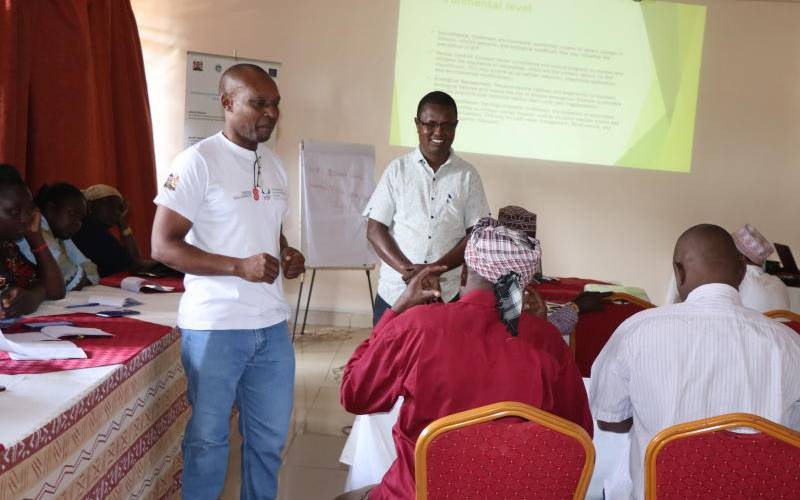Intelligence sources have warned that Al Shabaab is using the western part of the country as a new recruitment frontier.
And the Government is responding to these increased terror threats by tightening security laws, enhancing operations and institutional capacity to combat terrorism.
The National Intelligence Service (NIS) alerted President Uhuru Kenyatta that the terror group has added Rift Valley, Nyanza and Western to its traditional Coastal and Northern Kenya regions as new “fertile grounds for recruitment”.
The report adds a chilling disclosure that while the Kenyan Al Qaeda cell earlier consisted of mostly foreigners, "more recently Kenyan locals are joining the terrorist cell".
And terrorist recruiters are targeting university and secondary school students as well as prisons to breed terrorists ready for deployment.
"This radicalisation of the youth has led to frequent unrests in learning institutions and to several Kenyan youths being recruited as fighters," the State of National Security Annual Report to Parliament partly reads.
The aggressive campaign is part of the group's strategy to enhance its overall terror threat to the country.
According to the report, technological advances have enhanced terrorists' mobility and made them lethal as they are now able to easily facilitate the spread of extremist ideologies and propaganda on their activities.
But the Government has enhanced intelligence collection and sharing both locally and internationally, as well as enhanced and sustained security vigilance across the country.
"Intelligence has pointed out that Al Shabaab operatives and "Amniyat" (intelligence wing of Al Shabaab) are keenly looking for fertile grounds to recruit, radicalise and possibly attack targets within the country," the report partly reads.
According to intelligence sources, local grievances such as marginalisation are being exploited by Al Shabaab to infiltrate and recruit.
Unemployment is one of the pull-and-push factors that have seen some Kenyan youths join terror groups in Syria and other countries, says the report. The terrorists are also using social media to recruit, indoctrinate, gain sympathy and stir inter-religious animosity, the report adds.
"The radicals have developed an elaborate propaganda network which includes use of electronic media (videos and CDs) and mass media, and are more pronounced on social media to... justify their actions, intimidate moderate clerics and incite inter-religious animosity to derail the Government's counter-radicalisation efforts," the report says.
Other new techniques being employed by the terror group to drive its agenda include deploying Kenyan returnees and radicalised youth to execute terror activities.
Linked to this is the alarming report that more Kenyans are joining terror groups for training, and later are being used to attack the country.
Stay informed. Subscribe to our newsletter
The report also warns that the terrorists are using the tactic of fomenting and exploiting inter-religious and ethnic conflicts among communities.
It said the terror group is also sponsoring well-calculated programmes to indoctrinate Kenyan Muslims with extremist ideologies through madrassas.
The militiamen are also going for soft targets such as malls, churches, learning institutions and settlements inhabited by non-Muslims.
The intelligence report warns that terror groups are now targeting university and secondary school goers to create a pool of radicalised youth, who could be easily deployed for "terrorism mission... and the ultimate goal of creating an Islamic caliphate".
"A protracted state of instability, long porous borders and coastline has made Somalia a safe haven for international terrorists recruitment, training and launch pad for conducting operations across the region," observes the 42-page report.
Al Shabaab has waged a campaign of terror against Kenya that has claimed hundreds of lives. The deadliest were on Garissa University College in which 148, mostly students, were killed last year and Westgate Mall in Nairobi that saw the killing of 67 people in 2013.
Kenya went into Somalia in November 2011 under the Operation Linda Nchi, in hot pursuit of Somalia elements who had violated its territory by kidnapping tourists and aid workers inside Kenya.
 The Standard Group Plc is a
multi-media organization with investments in media platforms spanning newspaper
print operations, television, radio broadcasting, digital and online services. The
Standard Group is recognized as a leading multi-media house in Kenya with a key
influence in matters of national and international interest.
The Standard Group Plc is a
multi-media organization with investments in media platforms spanning newspaper
print operations, television, radio broadcasting, digital and online services. The
Standard Group is recognized as a leading multi-media house in Kenya with a key
influence in matters of national and international interest.
 The Standard Group Plc is a
multi-media organization with investments in media platforms spanning newspaper
print operations, television, radio broadcasting, digital and online services. The
Standard Group is recognized as a leading multi-media house in Kenya with a key
influence in matters of national and international interest.
The Standard Group Plc is a
multi-media organization with investments in media platforms spanning newspaper
print operations, television, radio broadcasting, digital and online services. The
Standard Group is recognized as a leading multi-media house in Kenya with a key
influence in matters of national and international interest.








